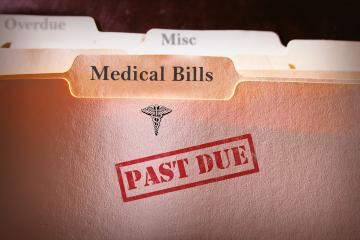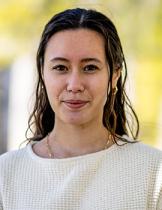
Exploring the benefits of rigorous evidence with the team behind the evaluation of RIP Medical Debt

Eighteen percent of Americans in 2020 had outstanding medical debt held by collection agencies, collectively totaling $140 billion of unpaid medical bills. RIP Medical Debt aims to reduce this burden by buying and relieving debt obligations at no cost to the debtors.
Researchers from the J-PAL network are currently working closely with RIP Medical Debt to evaluate the impact of their model on financial well-being and health outcomes. In conversation with J-PAL staff, Allison Sesso, Executive Director of RIP Medical Debt, and Wes Yin, primary investigator on the study, reflect on the journey of this ongoing evaluation.
Allison, let’s start at the beginning. What is the history of RIP Medical Debt and what is its mission?
RIP Medical Debt was founded in 2014 by two former debt collectors, Jerry Ashton and Craig Antico. Around the start of the Occupy Wall Street movement, they decided to put their industry experience toward forgiving debt rather than collecting on it. Our mission is to end medical debt and be a source of justice in an unjust health care finance system, a unique solution for patient-centered healthcare providers, and a moral force for systemic change.
And why was RIP Medical Debt interested in rigorous evaluation of its model?
No one has ever approached debt relief in this way before. RIP’s completely new philanthropic model mimics for-profit debt buyers by using fundraised dollars to purchase medical debt for pennies on the dollar. Prior to RIP's purchase, many of these medical bills passed through months or years of collection pursuit. Others are purchased or donated directly from hospitals and doctors’ groups. Once we own the debt, we notify the thousands of individuals whose debt we purchased that we are freeing them of the debt obligation for good.
Given the newness of this model, we felt it was critically important to understand how (and if) what we are doing provides real relief and the extent to which this supports debtors' economic, physical, and psychological well being. We also want to know if our work benefits those with specific circumstances or characteristics more than others so that we can focus our efforts to have the greatest impact.
Wes, why were you interested in working with the RIP Medical Debt on this evaluation?
As Allison discussed, RIP Medical Debt has developed a fascinating model of delivering charity benefits—a debt jubilee! The outsized presence of medical debt on household balance sheets (we’ve found that it now exceeds all other sources of debt in collections combined) raises questions about its implications for mental health, consumption, and household assets; and for how best to design debt forgiveness and prevention. These questions have not been studied with the rigor that field experiments can bring, and our research team and leadership at RIP Medical Debt all recognized the unique opportunity to build out a randomized evaluation to study these questions.
How did the research partnership between RIP Medical Debt and J-PAL North America come about, and how has the collaboration continued to be successful?
Allison: John Oliver. In 2016 RIP Medical Debt was highlighted on an episode of Last Week Tonight on HBO. Several researchers interested in medical debt learned about our work and reached out to the organization’s founders.
Wes: A special thanks goes out to both John Oliver and J-PAL. Based on that Last Week Tonight episode, Ray Kluender and Francis Wong reached out to RIP Medical Debt, which led to their interest in a randomized evaluation and RIP Medical Debt’s founders Jerry Ashton and Craig Antico attending a J-PAL North America conference.
Neale Mahoney and I met Jerry and Craig at that conference, where we also proposed ideas for what could be learned from a randomized evaluation. So John Oliver and J-PAL played a big role in bringing our research team and RIP Medical Debt together. Our mutual commitment to learning how medical debt impacts people, and how debt relief can best be designed, has sustained a successful and rewarding partnership.
Allison: I agree, I think our openness has helped make this partnership a success. We recognize that there is risk in having our work reviewed so rigorously. What if the research shows our impact is limited? What will that mean for what we have built and for our efforts to attract funding? But we care about our integrity and that requires us to prove our model is having an impact on the world. We also can’t refine and improve our model if we don’t know the details of who it is helping and why.
Wes, what has been exciting, as well as challenging, about the randomization and evaluation design process?
Integrating a study’s research design into the operations of an organization is always a challenge. In our case, leadership at RIP Medical Debt understood from the beginning the rationale of randomization and has been deeply invested in the outcome of the study, which has been a constant source of excitement.
The biggest challenges have come from the evaluation side. We implemented a survey to measure the well-being and health care utilization of study participants, but pandemic-related challenges caused declines in response rates. From there, we needed to pilot a number of other strategies before arriving at a solution. These delays created challenges, but also valuable lessons.
What advice do you both have for other organizations and researchers who are interested in partnering on a randomized evaluation?
Wes: Perhaps the most important attribute of a successful partnership is having shared goals, starting with a study designed to answer questions that are compelling to both the organization and scholars. Organizations should seek partners who are committed to gaining knowledge that benefits the organization; and researchers should understand the many risks of pursuing academically-compelling research that is not central to an organization’s goals.
Allison: While there are some risks for the organization as well, I believe the rewards far outweigh the downsides, so I say “Do it!”. Testing your model will help hold you accountable and allow you to focus your limited resources to have the greatest impact. It also ultimately helps bring in donors. Those providing support want to know you are holding yourself to a high standard and this kind of research helps you demonstrate that.
*Note: As of April 2024, RIP Medical Debt is knowns as Undue Medical Debt. This post reflects the organization's name when written.
Related Content

Forgive and Forget: The Impact of Medical Debt Forgiveness on Financial Outcomes in the United States

Reflecting on the benefits of evaluating a health care delivery program: A recap from the HCDI @ 8 Convening



